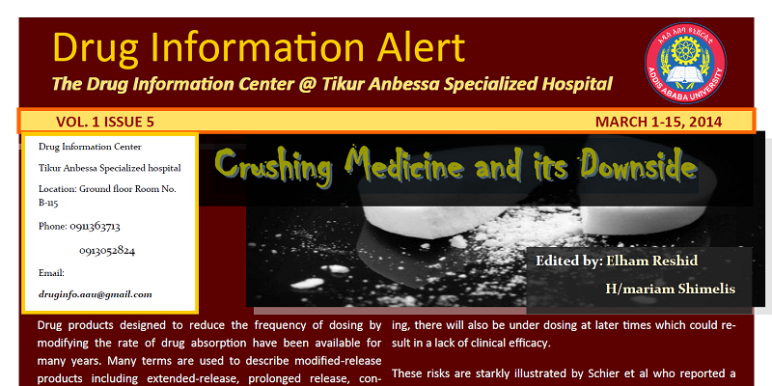Editors:
Elham Reshid and Hailemariam ShimelisDrug products designed to reduce the frequency of dosing by modifying the rate of drug absorption have been available for many years. Many terms are used to describe modified-release products including extended-release, prolonged release, controlled-release, controlled-delivery, slow-release and sustained-release. Among the advantages of these products include sus-tained blood levels, attenuation of adverse effects and improved patient compliance.
There are multiple reasons for crushing tablets or capsule contents before administering medications, – by both patients and healthcare professionals – for example, in cases where patients need their medicines and there are no alternative formulations available or they are taking the medications via Nasogastric tube (NGT). However, there are numerous medications that should not be crushed due to their specific formulations and their pharmacokinetic properties.

Most of the no-crush medications are modified release dosage forms, sustained-release, oral-dosage formulas and enteric coated tablets. The majority of extended release products should not be crushed or chewed, although there are some slow-release tablet formulations available that are scored and can be divided or halved (e.g. Toprol XL). Indeed, a survey in the United States found that 21% of critical care nurses (n=1167) reported routinely crushing and administering enteric-coated medications through feeding tubes. Similarly 15% reported routinely crushing sustained-release medications.
However these sustained-release products contain significantly higher amounts of active drug than are present in their normal release counterparts. The matrix contained in these drugs is actually a highly specialized delivery system which is destroyed by crushing. In most cases, tampering with these products damages the mechanism by which the medication is released. The consequence of this would be for a potentially toxic dose of medication to be delivered upon administration with an increased risk of ad-verse effects. Conversely, while there is the risk of initial overdosing, there will also be under dosing at later times which could result in a lack of clinical efficacy.
These risks are starkly illustrated by Schier et al who reported a case in which a woman diagnosed with acute pulmonary edema and pneumonia was administered labetalol and crushed nifedipine XL through the nasogastric tube. And the crushed extended-release (XL) nifedipine tablet contributed to a 38-year-old woman patient fatality by developing bradycardia with hypotension and ultimately died. In this instance the administration of a crushed nifedipine XL tablet resulted in severe hypotension and the con-current administration of labetalol prevented a compensatory heart rate increase in the patient.
Berkovitch et al also compared pharmacokinetic parameters be-tween frail elderly patients taking a sustained-release theophylline formulation twice daily orally (n = 17, group I) and those receiving it via NGT (n = 15, group II) for chronic obstructive lung disease. The result from the study revealed all pharmacokinetic measure-ments were lower in group I as compared with group II.
In conclusion, crushing modified release products could alter the pharmacokinetic behavior of the medicament and might elicit an exaggerated therapeutic response or toxicity. Thus, every health professional should refer to the specific package inserts before administration of such products to patients. One should take note that almost all sustained-release and controlled-release formula-tions are not to be crushed or opened.
To download the pdf click here.
References:
Lloyd N. Sansom. Oral extended-release products. Aust Prescr 1999;22:88-90.
http://dysphagia-medicine.com/splitting-and-crushing-tablets.html accessed date 19/4/2014 http://www.the-hospitalist.org/article/to-crush-or-not-to-crush/ accessed date 19/4/2014 Schier JG, Howland MA, Hoffman RS, Nelson LS.Fatality from administration of labetalol and crushed extended-release nifedipine. Ann Pharmacother. 2003 Oct; 3 Berkovitch M, Dafni O, Leiboviz A, Mayan H, Habut B, Segal R. Therapeutic drug monitoring of theophylline in frail elderly patients: oral compared with nasogastric tube administration. Ther Drug Monit. 2002 Oct; 24(5):594-7.
